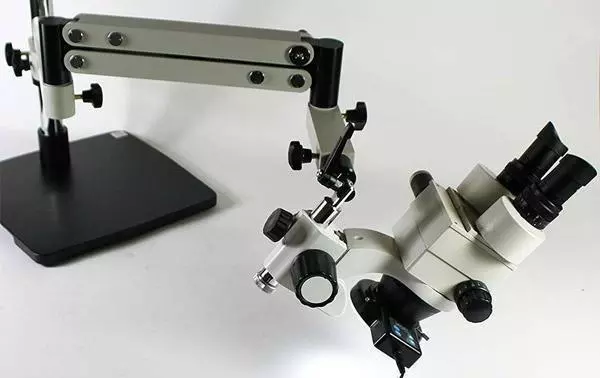Stereo Microscope
Stereo microscopes, also referred to as low magnification and dissecting microscopes, share several common and essential components. Firstly, a pair of angled objectives is present, which is typically concealed in the end/nose of the microscope. Each objective is linked to its own eyepiece and delivers a stereoscopic or three-dimensional view of the subject due to its angled design.
Another fundamental component is the microscope head, which houses all optical components and magnification-changing mechanisms. Various types of microscope heads are available, and this is the primary means of classifying and pricing different stereo microscopes. For example, single magnification heads necessitate the removal and insertion of various objectives and eyepieces to change magnification, and they typically have a rectangular objective holder.
Zoom magnification heads are popular because they allow for a continuous range of magnifications, which is controlled by a zoom knob. They may have a range of magnifications, such as 0.7X to 4.5X, with standard 10X eyepieces providing a total magnification of 7X to 45X. Additionally, auxiliary objectives, such as 0.5X, 0.75X, 1.5X, or 2X, can be added to alter the zoom magnification range proportionally and modify the working distance. This type of microscope can also accommodate a broad range of illumination accessories, such as ring lights. Furthermore, zoom microscopes with 'trinocular heads' (T suffix) offer an extra vertical photoport to which a camera can be attached with the proper camera adaptor, allowing for various photographic options.
In addition to the essential components above, there are several other features and considerations when selecting a stereo microscope. One of the key factors to consider is the working distance, which is the distance between the objective lens and the subject. A longer working distance allows for a larger range of sample sizes and makes it easier to manipulate the sample, while a shorter working distance provides a greater magnification. Another important consideration is the field of view, which refers to the size of the area visible through the microscope. A larger field of view can be beneficial when examining larger samples, while a smaller field of view is useful when examining smaller or more intricate samples.

Ergonomics is also a crucial aspect to consider, particularly when using the microscope for extended periods. Features such as adjustable height and angle of the eyepieces, as well as comfortable hand rests, can help reduce the risk of fatigue and repetitive strain injuries. Furthermore, some stereo microscopes come with a variety of accessories, including digital cameras, measurement software, and reticles, which can be used for image capture, analysis, and documentation. These features can be particularly useful in fields such as materials science, forensics, and quality control.
While all stereo microscopes share fundamental components such as angled objectives and a microscope head, there are several other factors to consider when selecting the most suitable microscope for a particular application. Factors such as working distance, field of view, ergonomics, and accessories should all be taken into account to ensure optimal performance and user comfort.
Stereo Microscope Illumination
Stereo microscope illumination is another critical component that Kemet offers a wide range of systems for. Fibre optic illumination systems, for instance, are made up of two main components: a lamphouse and a fibre optic light guide. LED illuminators and LED ring illuminators provide excellent white colour temperature, cool light with long-lasting LED lamp life and minimal intensity decay over time. Spot lamps, which come in a variety of formats and lamp types, are a cost-effective solution for many inspection tasks.
Stereo Zoom Microscope for Through Axis Observation
The ideal stereo zoom microscope is perfect for a wide range of tasks involving precision work under a microscope, such as dissections, electronics assembly, gem setting, jewelry manufacturing, fine engraving, and more. Its exceptional qualities make it stand out. This microscope aligns its optical path directly in line with your view, different from conventional microscopes with eyepieces offset at a 45-degree angle. This "through-axis" design enhances hand-eye coordination, making tasks more intuitive, relaxed, and controlled, similar to surgical microscopes.
SICZ (Simultaneous Independent Camera Zoom):
The microscope is equipped with a set of optical zoom components dedicated to the camera. These components move in sync with the two viewing zoom objectives, offering significant advantages:
- Simultaneous viewing through both eyepieces and the camera.
- No light sharing to the camera port, ensuring 100% of the light reaches the camera.
- A more direct view, with camera optics configured for a less oblique perspective.
- An erect image to the camera, simplifying movement guided by the camera image alone.
- It effectively combines a 3D Stereo Zoom microscope with a Monozoom photography system in one device.
The microscope head is compatible with various microscope stands featuring an 84mm microscope head holder, providing flexibility in stand selection. This professional-grade zoom stereo microscope boasts high optical quality, a modern stand, and build quality typically found in more expensive systems. As a testament to its durability, a lifetime warranty offer is extended to all users. The UltraZoom-6 AXIAL ZOOM offers a magnification zoom range from 7X to 45X, expandable to an impressive 1.05X to 360X with additional options. It comes with 10X widefield eyepieces and rubber eyeguards. Every microscope includes a side-mounted Camera Port, and it comes with a 0.5X c-mount adapter pre-installed. Additional adapters are available for various sensor sizes and camera types, like DSLRs. The microscope features an advanced Simultaneous Independent Camera Zoom optical system on the trinocular head for live image viewing, capture, and analysis. The UltraZoom-6 AXIAL ZOOM features top-quality coated optics, delivering a bright, high-resolution 3D image. This effect is achieved through angled zoom objectives, each offering a slightly different view of the subject, which is transmitted to each eyepiece.

